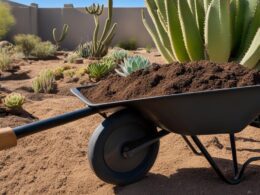In order to maintain the beauty and health of your landscape trees and shrubs, proper pruning and trimming techniques are essential. Pruning allows you to train plants, improve their health, enhance flower or fruit quality, and control their growth. By selecting the right plants for your location, you can minimize the need for excessive pruning. It’s important to follow a plan and prune at the appropriate time to minimize any potential damage to the plants.
Key Takeaways:
- Proper pruning is crucial for maintaining the health and aesthetics of xeriscape plants.
- Pruning should be done to train plants, improve their health, and control their growth.
- Selecting the right plants for your location can reduce the need for excessive pruning.
- Pruning should follow a plan and be done at the appropriate time to minimize damage.
- Regularly assess the needs of your plants to ensure a beautiful and healthy landscape.
The Importance of Pruning
Proper pruning plays a crucial role in maintaining the health and visual appeal of your xeriscape plants. By understanding the importance of pruning, you can enhance your landscape’s potential and ensure the longevity of your plants.
Pruning is not only about aesthetics; it is also essential for plant health. By removing dead or damaged branches, you can minimize the risk of disease or infestations. Pruning also promotes air circulation and sunlight penetration, which are vital for the overall well-being of your plants. Additionally, by selectively removing branches, you can improve the flower or fruit quality and stimulate new growth.
Another advantage of proper pruning is the ability to restrict the growth of your plants. This is especially important for xeriscape plants that have specific space limitations. By carefully removing unwanted branches, you can control the size and shape of your plants, ensuring they fit perfectly into your landscape design.
“Proper pruning enhances the beauty of landscape trees and shrubs, while improper pruning can ruin their potential.”
Maximizing Your Landscape’s Potential
When it comes to your xeriscape plants, pruning is a key component in maximizing their potential. By practicing proper pruning techniques, you can shape your plants into beautiful focal points, highlight their natural features, and create an appealing landscape that reflects your personal style.
However, it is important to approach pruning with care. Improper pruning methods can weaken or deform your plants and have long-term negative effects. That’s why it’s crucial to follow a plan and prune at the right time. By doing so, you can minimize damage and ensure the long-term health and vitality of your xeriscape plants.
Remember, when it comes to pruning, it’s not just about grabbing a pair of shears and cutting away. It requires an understanding of your plants’ growth patterns, knowledge of proper techniques, and a vision for how you want your landscape to look. By investing time and effort into pruning, you can create a visually stunning and healthy environment that you can enjoy for years to come.
Pruning Techniques
Proper pruning techniques are crucial for maintaining the health and aesthetics of your xeriscape plants. By following these techniques, you can ensure that your plants grow strong and maintain their desired shape.
Training Cuts
One important aspect of pruning is making training cuts to shape the plant. This involves selectively removing branches that are growing in undesirable directions or interfering with the overall form of the plant. By strategically pruning these branches, you can encourage the plant to grow in the desired direction and maintain a neat appearance.
Corrective Prunings
In addition to training cuts, corrective prunings are necessary to correct any issues with the plant’s structure. This includes removing weak or narrow crotches, which can lead to future limb breakage. It’s important to identify these structural issues early on and address them through proper pruning techniques.
When conducting corrective prunings, it’s essential to step back and assess the plant’s overall form. By taking a holistic approach, you can ensure that your pruning work is effective in improving the plant’s health and appearance.
- Water Sprouts: Water sprouts are upright shoots that grow vigorously from the base or main branches of the plant. Unless needed to fill a gap or provide shade, water sprouts can be pruned to maintain a more balanced and aesthetically pleasing plant shape.
Remember, pruning is not just about randomly cutting branches. It’s about understanding the plant’s growth pattern, identifying and addressing structural issues, and guiding the plant to grow in the desired direction.
By utilizing these pruning techniques, including training cuts and corrective prunings, you can promote the health and growth of your xeriscape plants while maintaining their desired shape. Just remember to assess the plant’s overall form and make thoughtful pruning decisions to achieve the best results.
When to Prune
Knowing the best time to prune your plants is crucial for their health and growth. While pruning can be done at any time of the year, it is generally recommended to prune most plants in late winter or early spring before new growth begins. Pruning during this time allows the plants to recover and heal before the active growing season.
Pruning after new growth in spring should be avoided as it can lead to dwarfing of the plant. Additionally, pruning in late summer should be limited to prevent stimulating new growth that may not have enough time to harden off before winter arrives.
Best Time to Prune Different Plants
- Deciduous trees and shrubs: Prune during late winter or early spring while the plants are still dormant.
- Evergreen trees and shrubs: Prune in early spring before new growth starts.
- Flowering shrubs: Prune immediately after flowering to avoid removing the buds for next year’s blooms.
- Fruit trees: Prune during late winter or early spring before bud break.
- Roses: Prune in early spring before new growth begins.
By pruning your plants at the right time, you can promote healthy growth, enhance their appearance, and maintain the overall balance of your landscape. However, it’s important to note that specific plants may have different requirements, so it’s always a good idea to consult plant-specific guides or seek advice from a professional if you are uncertain about the best time to prune a particular plant.
Pruning Equipment
When it comes to pruning, having the right tools can make all the difference in achieving successful results. Using the correct pruning equipment ensures clean cuts, minimizes damage to plants, and promotes overall plant health. Here are some essential pruning tools every gardener should have:
- Hand Pruning Shears: These are ideal for cutting stems up to 1/2 inch in diameter. They provide precision and control for shaping and fine pruning.
- Lopping Shears: Designed for branches up to 2 inches in diameter, lopping shears offer the extra leverage needed to tackle larger cuts.
- Pole Pruners: For reaching higher branches without the need for a ladder, pole pruners are invaluable. They come with an extendable pole and a cutting mechanism at the end, allowing for convenient and safe trimming.
- Pruning Saws: Used for larger branches and trees, pruning saws have longer blades and aggressive teeth that make cutting through thicker wood easier.
Remember, it’s essential to keep your pruning tools sharp and well-maintained. Dull tools can tear the plant tissue instead of making clean cuts, which can lead to damage and disease. Regularly clean your tools with a disinfectant solution to prevent the spread of pathogens between plants.
Proper Pruning Equipment Ensures Effective Cutting and Plant Health
Using the correct tools is important for successful pruning.
By investing in the right pruning equipment, you’ll be equipped to tackle any pruning task with confidence, from shaping small shrubs to trimming large trees. Remember to always follow proper pruning techniques and guidelines to ensure the best results for your landscape.
How Should I Trim and Prune Perennials in My Xeriscape Garden?
When trimming and pruning perennials in your xeriscape garden, it’s important to start by identifying the best perennials for xeriscape. Select low-maintenance, drought-tolerant plants such as lavender, yarrow, and Russian sage. Prune dead or damaged stems, and trim back overgrown growth to promote healthy, water-efficient plants in your xeriscape garden.
Trimming Tips for Shrubs and Bushes
When it comes to maintaining the beauty of your landscape, trimming shrubs and bushes is an essential task. Proper trimming not only keeps your plants healthy, but it also enhances the overall appearance of your garden. To help you achieve the desired shape and look, here are some useful trimming tips:
1. Plan the Desired Shape
Before starting the trimming process, take a moment to envision the shape you want to achieve for your shrubs and bushes. Consider the natural growth pattern of the plant and aim to accentuate its unique characteristics. Planning ahead will make the trimming process more efficient and ensure that you achieve your desired results.
2. Use Hedge Trimmers
When it comes to trimming shrubs and bushes, hedge trimmers are your best friend. These specialized tools have sharp blades designed to cut through branches with ease. Make sure to use the appropriate size trimmer for the thickness of the branches you are cutting. Start from the bottom of the plant and work your way up, trimming small sections at a time to maintain control over the shape.
3. Don’t Overtrim
While it may be tempting to go overboard with trimming, it’s important not to overtrim your shrubs and bushes. Overtrimming can weaken the plant and lead to stunted growth. Remember to step back frequently and assess the progress to ensure that you are achieving a balanced and natural look. It’s better to trim conservatively and make further adjustments if necessary.
By following these trimming tips, you can maintain the health and visual appeal of your shrubs and bushes. Remember to plan the desired shape, use hedge trimmers for precision, and avoid overtrimming. With regular maintenance and care, your landscape will flourish with beautifully trimmed plants.
Conclusion
Pruning and trimming are essential practices for maintaining the health and visual appeal of xeriscape plants. By understanding the importance of pruning and trimming, you can enhance the growth and shape of your plants, while avoiding weakening or deformation. It is crucial to follow proper pruning techniques, such as making training cuts and removing weak or narrow crotches. Regularly assessing the needs of your plants and using the right pruning tools will ensure successful landscape maintenance.
Knowing when to prune is equally important. Late winter or early spring, before new growth begins, is generally the best time to prune most plants. Avoid pruning after new growth in the spring to prevent stunting the plant’s growth. Similarly, limiting pruning in late summer will help prevent stimulating new growth that may not have time to harden off before winter.
Proper landscape maintenance requires you to have the right tools for the job. Hand pruning shears, lopping shears, pole pruners, and pruning saws are some of the tools commonly used for pruning and trimming. Remember to keep your tools sharp and well-maintained to ensure effective cutting and to prevent the spread of diseases.
In conclusion, by following established pruning guidelines, understanding the importance of pruning, knowing when to prune, and using the right tools, you can maintain a beautiful and healthy landscape. Regularly assess the needs of your plants, keep up with proper pruning techniques, and your xeriscape plants will thrive, enhancing the overall beauty of your outdoor space.












